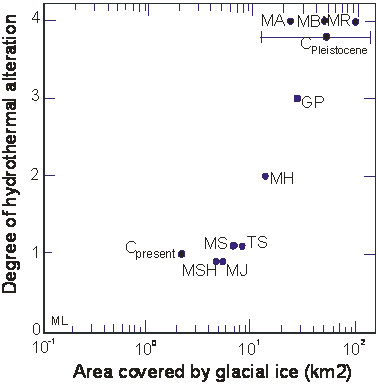

| Carrasco-Núñez
et al. (1993) proposed that the presence of glacier ice and a very active
hydrothermal system during late Pleistocene time provided a constant supply
of pore water, which enhanced the hydrothermal alteration of the summit of
Citlaltépetl and was the origin of most of the water for the lahar. The
intense hydrothermal alteration seems to be related to an acid-sulfate
leaching process where sulfates are added, while mobile elements are removed
from the surroundings rocks to form clay, silica, and sulfate minerals. |
|
| Plot of the
degree of hydrothermal alteration (area and intensity) versus and the area
covered by glacial ice for the Cascade volcanoes and Citlaltépetl (from
Carrasco-Núñez et al., 1993). 0-no alteration; 1- small areas of moderate
alteration; 2- moderate alteration; 3- large areas of moderate alteration; 4-
large intensely-altered rocks. C-Citlaltépetl, GP- Glacier Peak; MA-Mount
Adams; MB-Mount Baker; MH-Mount Hood; MJ- Mount Jefferson; ML- Mount Lassen;
MR-Mount Rainier; MS-Mount Shasta; MSH- Mount St. Helens; TS-Three Sisters. |